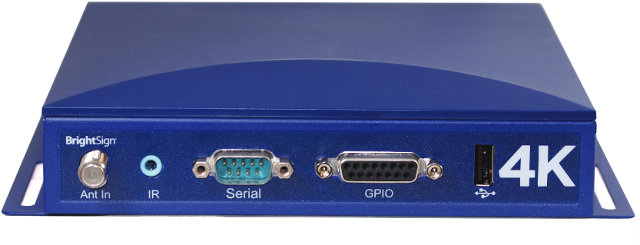When you buy a media player advertized as supporting 4K (aka 2160p, 4K2K, or UHD), you have to read the fine print to find out what you really get. First on the market were media players capable of decoding 4K videos put outputting to 1080p60 maximum such as Mele M9, then we’ve been shown some media players such as Geniatech ATV1800, decoding 4K video using 2160p resolution (3840×2160) as expected, but with a framerate limited to 24 fps or 30 fps due to limitation of HDMI 1.4. However, if you want to experience 4K video with the maximum framerate (60 fps) or “True 4K”, you’ll need a player and a TV support HDMI 2.0 standard. There are not many players currently supporting 4K @ 60fps, but BrightSign 4K digital signage media player is one of them, and it also happens to support HEVC/H.265 video codec.
 The company did not disclose hardware specifications, but they did provide the key “user” features for their player:
The company did not disclose hardware specifications, but they did provide the key “user” features for their player:
- Native video playback – 4K video at 3840×2160 resolution H.265 via HDMI 2.0 out at 60 fps
- Video Engine – Supports native 4K video content or two 1080p videos simultaneously
- Hardware accelerated HTML5
- IP Streaming (HLS, UDP/RTP/RTSP, HTTP, SHOUTcast), IP Streaming server, UDP control
- Live TV – Either using ATSC/Clear QAM tuner or HDMI input
- Interactivity – Playback can be triggered from barcode scanners, motion sensors, RFID, GPIOs, USB buttons, touch screens, IR remotes, serial devices, keyboards, mice, etc..
- Geo-fencing – Play content targeted to location via USB GPS dongle
- Digital sound via SPDIF output
Brighsign offers provides content authoring and player signage tools such as the company’s BrightWall, BrightAuthor, and BrightSign App with support for multiple zones, live feeds, sign preview, etc.. The players runs the company’s “Slim OS”, which could be a Linux distribution, but no details are provided.
Brightsign previous models (XD230, XD1030, XD1230) are based on Broadcom BCM7421, so I would not be surprised if BrightSign 4K was also powered by a Broadcom SoC, specifically BCM7445 released early last year with Brahma15, a 4 core ARMv-7 compliant processor (Cortex-A15 equivalent), as well as 4K @ 60fps, and HDMI 2.0 support. However, HEVC decoding is said to be handled by Elemental Technologies HEVC video engine in BrightSign 4K, and the implementation makes use of GPU capabilities, so this digital media player could also be an x86 + GPU solution.
BrighSign 4K will be available in Q3 2014 for less than $1,000. Check out BrightSign 4K page for more information.

Jean-Luc started CNX Software in 2010 as a part-time endeavor, before quitting his job as a software engineering manager, and starting to write daily news, and reviews full time later in 2011.
Support CNX Software! Donate via cryptocurrencies, become a Patron on Patreon, or purchase goods on Amazon or Aliexpress




